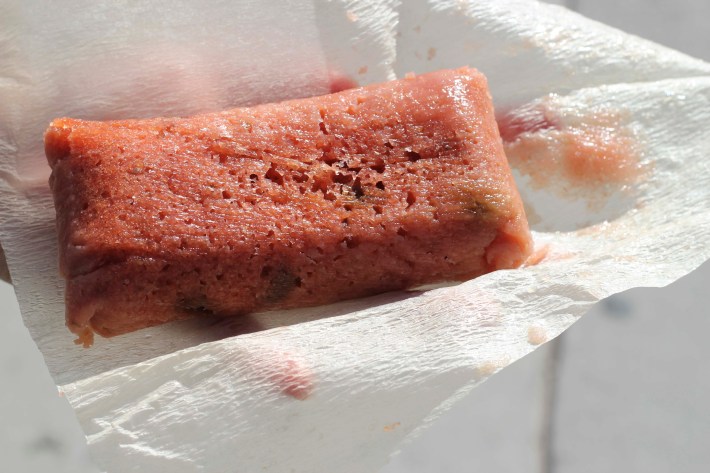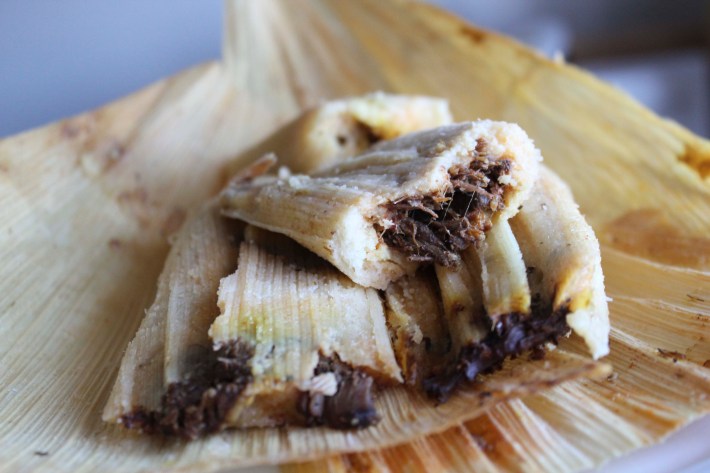Tamal versus tamale. The argument always comes up around this time of the year across the country as we all eat our body’s worth—at least—of tamales. And it turns out that your stance on the way to properly address a singular form of tamales has a lot more to do with your identity, nostalgia, and tolerance of the evolution of the Spanish language.
I’ve always been of the tamal school of masa thought. And I’m guilty of getting on my high horse and correcting people I thought were mispronouncing it by saying “tamale” in English as though it were singular. In proper Spanish, a tamal is singular, and tamales are plural.
That was until a response to one of my annual #tamalnottamale posts from writer and investigative reporter Aura Bogado made me question everything. She was the first to educate me on the cosmic fallacy of correcting people that say "tamale."
It was a bombshell: In Nahuatl, tamales have always been called "tamali" (singular).
Is it possible that the seemingly bastardized English word for a single tamal has been the correct way to say it all along? Even before linguists could analyze the root of the word or its evolution into the American lexicon?
Tamale, even if it makes you cringe, is not technically wrong. It’s both a bonafide entry in the Oxford English language dictionary and is listed as singular in the Associated Press Stylebook, which is the omnipotent bible journalists strive to follow on a letter-by-letter basis.
The reasoning is that tamale is the English translation or anglicization of the word tamal, a lonely distinction. Most other famous Mexican dish changes do not change when they make the journey to an English-speaking country. A taco is a still a taco, a tostada is a tostada, a sope is a sope, an enchilada is an enchilada, and so on. All of this still doesn’t change the fact that hearing it or reading it makes a lot of us, who grew up eating them and asking our mamás and abuelas nicely for one more tamal, cringe.
RELATED: The 23 Best Tamales in L.A.

I asked Mr. Modern Mexican Cuisine himself, Chef Enrique Olvera, what team he is on and how he presents the dish in both his Spanish and English menus at his 15 internationally renowned restaurants. (It’s soon to be 16, with his new restaurant in Los Angeles opening in 2019.)
“I am on team tamal,” he confirmed to L.A. TACO via email. “That is how we write it in Spanish, and tamale just sounds weird.” Olvera also won’t go out of his way to correct you if you say tamale in front of him. “Maybe when I am older, I will become more grumpy, but for now, let people call tamales what they want.”
However, if you are in front of chef Carlos Salgado, the pioneering Mexican-American James Beard Award semi-finalist who created Taco Maria in Costa Mesa–it’s a different story.
“I’ll correct anyone, kindly,” he tells me over the phone while he prepares tamales for this holiday season using chalqueño heirloom corn from Mexico for his masa.
Still, Salgado is forgiving if it is an honest mistake.
“You usually get a sense pretty quickly of people who generally respect language and food but don’t know any better and those who are saying it as a way of exotifying and folklorizing something that doesn’t need to be exotic or folkloric,” he says.
He admits that he is not a linguistic scholar and hasn’t studied all of Mexico’s regions, but in his view, tamale should always be tamal. Although he admits that as he’s gotten older, he’s chilled out a bit.
“In my maturity, I try not to engage with as many people as I used to about this. After all, I’m not interested in pushing people away. I’m interested in people just respecting people and culture and eating tamales.”
But what are your thoughts on the masa matter if you’re a Mexican food enthusiast but not a native speaker of Spanish? You’ll probably use tamale proudly because you don’t speak Spanish, so why pretend that you do?
“You know there’s the right way to pronounce mozzarella or croissant, but if you do that as a non-native speaker, you can sound more pretentious or annoying than if you just use the accepted non-native incorrect pronunciation,” says Brett Adams, an avid at-home taquero who took this now iconic photo of a tortilla puffing up that has been turned into countless memes.
Then you have the people who were born a "tamale" and have grown into "tamal," or vice versa. Like Melissa Montalvo, a third-generation Mexican-American born in Moreno Valley, raised in Arizona, and now lives in Fresno as a reporter for The Fresno Bee.
“It’s a process,” she says over Instagram in a poll I conducted, in which 131 people voted for tamal and only 43 followers voted for tamale. “I grew up not speaking tons of Spanish, so tamal-ee was what I knew! But I adapted to tamal in Guadalajara, but still use them interchangeably.”
Same with Taco USA author Gustavo Arellano, who has evolved over the years and come a long way from 2011 when he wrote that the word “tamale” was a case of “outright mongrelization” and that we shouldn’t “allow Manifest Destiny to claim another Mexican culinary icon ala chili.”
A quick check-in with him in reveals that Arellano is now of the “IT’S BOTH, MY FUCKING GOD” school of masa thought.
RELATED: The True Story of How National Taco Day Was Invented — Then Appropriated

“People tend to get attached to how they’ve been taught to say words in español at home,” says Elizabeth Flores, an editor at Cultura Colectiva, based in Mexico City. She is a professional translator and has translated more than a dozen books from English to Spanish and the other way around. Some are about food, like this one about tomatoes for Fundación Grupo México.
According to her, the “tamal vs. tamale” debate has “an almost emotional connection” with people simply because it becomes a “how my family speaks the language vs. how it’s ‘supposed to be’ written” type of language conflict. In a culture like Mexico, where family always comes before anything, it makes sense that people will go with what feels familiar rather than what they are expected to say.
As for the fact that it sounds a whole lot like the original Nahuatl word for tamales, Flores confirms that it’s a case of true irony. Yes, tamale phonetically sounds exactly like the original word, but it is wrong in Spanish.
RELATED: An Ode to Oaxacan L.A. ~ Friday Nights at Poncho’s Tlayudas

The one thing that everyone can agree on, regardless of race, language, or background, is to continue eating tons of tamales and use the most comfortable form. Language is constantly evolving, and no one really has any control over it, so there is not much use in trying to confine such a transient thing to rules.
Olvera feels the same. “I think we should not only be tolerant but accepting of [tamal vs. tamale] diversity and let freedom rule the world.”
As for me? I’m still team tamal because my Mexican wife will crucify me if she ever hears me say tamale while speaking English.
But really, all of this is pointless because who only eats one tamal or tamale anyway? Its singular form is almost irrelevant.
ALSO BY AUTHOR:
The Harsh Reality: Why This High Profile Chef Helped Her Employee's Relative Escape El Salvador
In Defense of the $5 Taco: It's Time to Embrace Our New Reality
How to Tell You're Eating a Fake Blue Corn Tortilla: Kernel of Truth Organics Has a Mission







